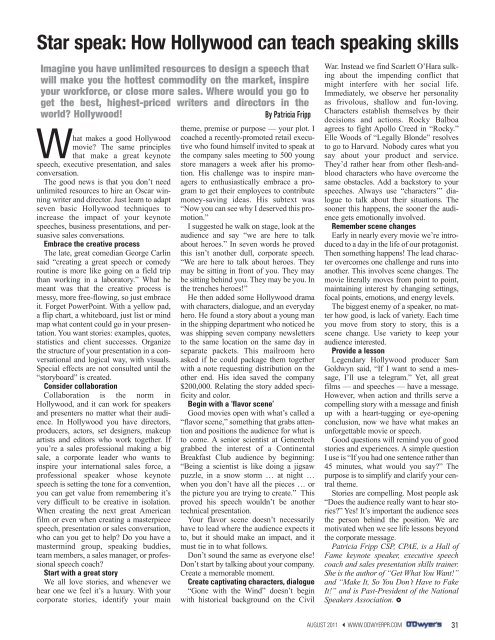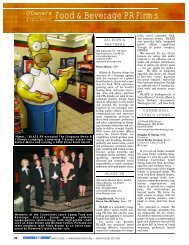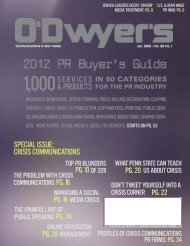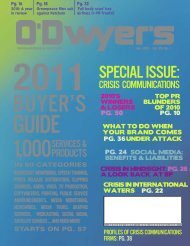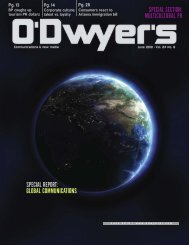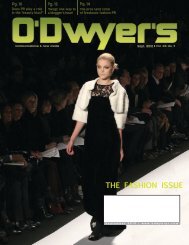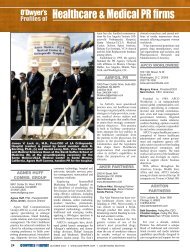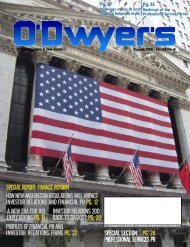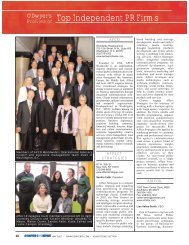and the market - Odwyerpr.com
and the market - Odwyerpr.com
and the market - Odwyerpr.com
You also want an ePaper? Increase the reach of your titles
YUMPU automatically turns print PDFs into web optimized ePapers that Google loves.
Star speak: How Hollywood can teach speaking skills<br />
Imagine you have unlimited resources to design a speech that<br />
will make you <strong>the</strong> hottest <strong>com</strong>modity on <strong>the</strong> <strong>market</strong>, inspire<br />
your workforce, or close more sales. Where would you go to<br />
get <strong>the</strong> best, highest-priced writers <strong>and</strong> directors in <strong>the</strong><br />
world Hollywood!<br />
By Patricia Fripp<br />
What makes a good Hollywood<br />
movie The same principles<br />
that make a great keynote<br />
speech, executive presentation, <strong>and</strong> sales<br />
conversation.<br />
The good news is that you don’t need<br />
unlimited resources to hire an Oscar winning<br />
writer <strong>and</strong> director. Just learn to adapt<br />
seven basic Hollywood techniques to<br />
increase <strong>the</strong> impact of your keynote<br />
speeches, business presentations, <strong>and</strong> persuasive<br />
sales conversations.<br />
Embrace <strong>the</strong> creative process<br />
The late, great <strong>com</strong>edian George Carlin<br />
said “creating a great speech or <strong>com</strong>edy<br />
routine is more like going on a field trip<br />
than working in a laboratory.” What he<br />
meant was that <strong>the</strong> creative process is<br />
messy, more free-flowing, so just embrace<br />
it. Forget PowerPoint. With a yellow pad,<br />
a flip chart, a whiteboard, just list or mind<br />
map what content could go in your presentation.<br />
You want stories: examples, quotes,<br />
statistics <strong>and</strong> client successes. Organize<br />
<strong>the</strong> structure of your presentation in a conversational<br />
<strong>and</strong> logical way, with visuals.<br />
Special effects are not consulted until <strong>the</strong><br />
“storyboard” is created.<br />
Consider collaboration<br />
Collaboration is <strong>the</strong> norm in<br />
Hollywood, <strong>and</strong> it can work for speakers<br />
<strong>and</strong> presenters no matter what <strong>the</strong>ir audience.<br />
In Hollywood you have directors,<br />
producers, actors, set designers, makeup<br />
artists <strong>and</strong> editors who work toge<strong>the</strong>r. If<br />
you’re a sales professional making a big<br />
sale, a corporate leader who wants to<br />
inspire your international sales force, a<br />
professional speaker whose keynote<br />
speech is setting <strong>the</strong> tone for a convention,<br />
you can get value from remembering it’s<br />
very difficult to be creative in isolation.<br />
When creating <strong>the</strong> next great American<br />
film or even when creating a masterpiece<br />
speech, presentation or sales conversation,<br />
who can you get to help Do you have a<br />
mastermind group, speaking buddies,<br />
team members, a sales manager, or professional<br />
speech coach<br />
Start with a great story<br />
We all love stories, <strong>and</strong> whenever we<br />
hear one we feel it’s a luxury. With your<br />
corporate stories, identify your main<br />
<strong>the</strong>me, premise or purpose — your plot. I<br />
coached a recently-promoted retail executive<br />
who found himself invited to speak at<br />
<strong>the</strong> <strong>com</strong>pany sales meeting to 500 young<br />
store managers a week after his promotion.<br />
His challenge was to inspire managers<br />
to enthusiastically embrace a program<br />
to get <strong>the</strong>ir employees to contribute<br />
money-saving ideas. His subtext was<br />
“Now you can see why I deserved this promotion.”<br />
I suggested he walk on stage, look at <strong>the</strong><br />
audience <strong>and</strong> say “we are here to talk<br />
about heroes.” In seven words he proved<br />
this isn’t ano<strong>the</strong>r dull, corporate speech.<br />
“We are here to talk about heroes. They<br />
may be sitting in front of you. They may<br />
be sitting behind you. They may be you. In<br />
<strong>the</strong> trenches heroes!”<br />
He <strong>the</strong>n added some Hollywood drama<br />
with characters, dialogue, <strong>and</strong> an everyday<br />
hero. He found a story about a young man<br />
in <strong>the</strong> shipping department who noticed he<br />
was shipping seven <strong>com</strong>pany newsletters<br />
to <strong>the</strong> same location on <strong>the</strong> same day in<br />
separate packets. This mailroom hero<br />
asked if he could package <strong>the</strong>m toge<strong>the</strong>r<br />
with a note requesting distribution on <strong>the</strong><br />
o<strong>the</strong>r end. His idea saved <strong>the</strong> <strong>com</strong>pany<br />
$200,000. Relating <strong>the</strong> story added specificity<br />
<strong>and</strong> color.<br />
Begin with a ‘flavor scene’<br />
Good movies open with what’s called a<br />
“flavor scene,” something that grabs attention<br />
<strong>and</strong> positions <strong>the</strong> audience for what is<br />
to <strong>com</strong>e. A senior scientist at Genentech<br />
grabbed <strong>the</strong> interest of a Continental<br />
Breakfast Club audience by beginning:<br />
“Being a scientist is like doing a jigsaw<br />
puzzle, in a snow storm … at night …<br />
when you don’t have all <strong>the</strong> pieces … or<br />
<strong>the</strong> picture you are trying to create.” This<br />
proved his speech wouldn’t be ano<strong>the</strong>r<br />
technical presentation.<br />
Your flavor scene doesn’t necessarily<br />
have to lead where <strong>the</strong> audience expects it<br />
to, but it should make an impact, <strong>and</strong> it<br />
must tie in to what follows.<br />
Don’t sound <strong>the</strong> same as everyone else!<br />
Don’t start by talking about your <strong>com</strong>pany.<br />
Create a memorable moment.<br />
Create captivating characters, dialogue<br />
“Gone with <strong>the</strong> Wind” doesn’t begin<br />
with historical background on <strong>the</strong> Civil<br />
War. Instead we find Scarlett O’Hara sulking<br />
about <strong>the</strong> impending conflict that<br />
might interfere with her social life.<br />
Immediately, we observe her personality<br />
as frivolous, shallow <strong>and</strong> fun-loving.<br />
Characters establish <strong>the</strong>mselves by <strong>the</strong>ir<br />
decisions <strong>and</strong> actions. Rocky Balboa<br />
agrees to fight Apollo Creed in “Rocky.”<br />
Elle Woods of “Legally Blonde” resolves<br />
to go to Harvard. Nobody cares what you<br />
say about your product <strong>and</strong> service.<br />
They’d ra<strong>the</strong>r hear from o<strong>the</strong>r flesh-<strong>and</strong>blood<br />
characters who have over<strong>com</strong>e <strong>the</strong><br />
same obstacles. Add a backstory to your<br />
speeches. Always use “characters’” dialogue<br />
to talk about <strong>the</strong>ir situations. The<br />
sooner this happens, <strong>the</strong> sooner <strong>the</strong> audience<br />
gets emotionally involved.<br />
Remember scene changes<br />
Early in nearly every movie we’re introduced<br />
to a day in <strong>the</strong> life of our protagonist.<br />
Then something happens! The lead character<br />
over<strong>com</strong>es one challenge <strong>and</strong> runs into<br />
ano<strong>the</strong>r. This involves scene changes. The<br />
movie literally moves from point to point,<br />
maintaining interest by changing settings,<br />
focal points, emotions, <strong>and</strong> energy levels.<br />
The biggest enemy of a speaker, no matter<br />
how good, is lack of variety. Each time<br />
you move from story to story, this is a<br />
scene change. Use variety to keep your<br />
audience interested.<br />
Provide a lesson<br />
Legendary Hollywood producer Sam<br />
Goldwyn said, “If I want to send a message,<br />
I’ll use a telegram.” Yet, all great<br />
films — <strong>and</strong> speeches — have a message.<br />
However, when action <strong>and</strong> thrills serve a<br />
<strong>com</strong>pelling story with a message <strong>and</strong> finish<br />
up with a heart-tugging or eye-opening<br />
conclusion, now we have what makes an<br />
unforgettable movie or speech.<br />
Good questions will remind you of good<br />
stories <strong>and</strong> experiences. A simple question<br />
I use is “If you had one sentence ra<strong>the</strong>r than<br />
45 minutes, what would you say” The<br />
purpose is to simplify <strong>and</strong> clarify your central<br />
<strong>the</strong>me.<br />
Stories are <strong>com</strong>pelling. Most people ask<br />
“Does <strong>the</strong> audience really want to hear stories”<br />
Yes! It’s important <strong>the</strong> audience sees<br />
<strong>the</strong> person behind <strong>the</strong> position. We are<br />
motivated when we see life lessons beyond<br />
<strong>the</strong> corporate message.<br />
Patricia Fripp CSP, CPAE, is a Hall of<br />
Fame keynote speaker, executive speech<br />
coach <strong>and</strong> sales presentation skills trainer.<br />
She is <strong>the</strong> author of “Get What You Want!”<br />
<strong>and</strong> “Make It, So You Don’t Have to Fake<br />
It!” <strong>and</strong> is Past-President of <strong>the</strong> National<br />
Speakers Association. <br />
AUGUST 2011 WWW.ODWYERPR.COM 31


